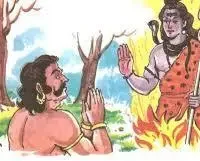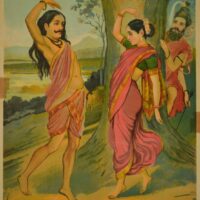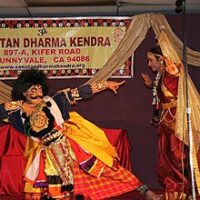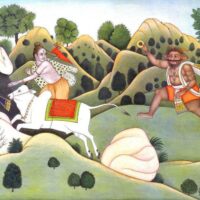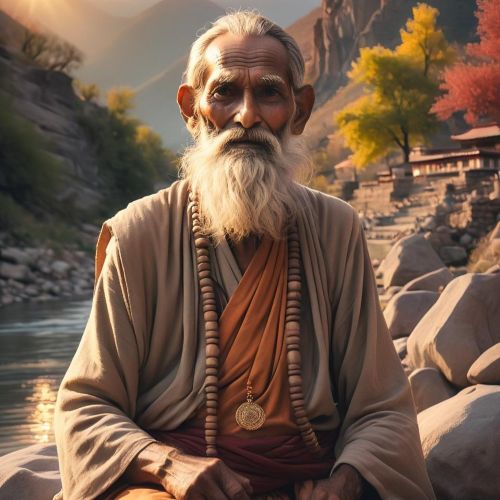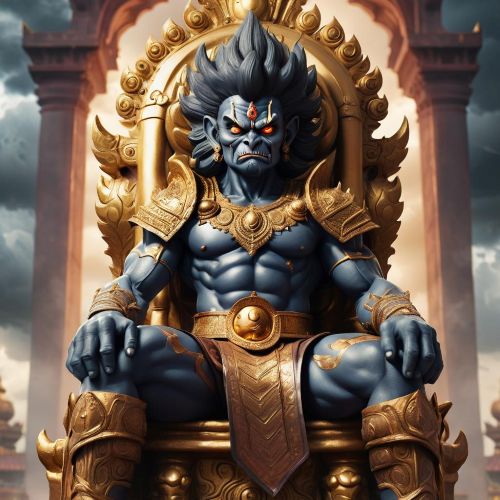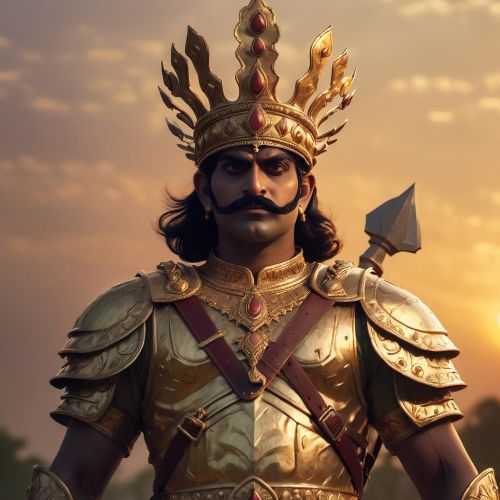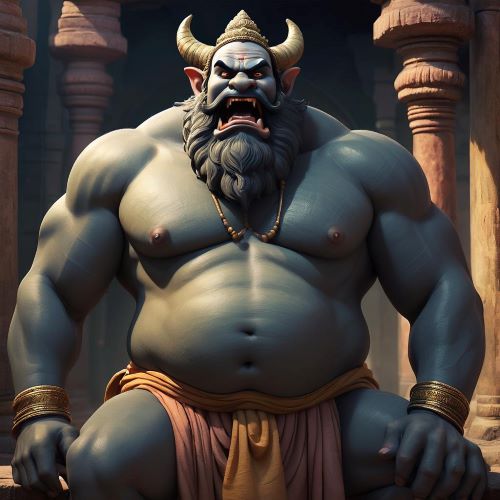Bhasmasura : The Ash Demon
Listen
At a glance
| Description | |
|---|---|
| Origin | Indian Mythology |
| Classification | Mortals |
| Family Members | Kashyapa (Father), Diti (Mother) |
| Region | India |
| Associated With | Super Strength, Fire and Ashes |
Bhasmasura
Introduction
Bhasmasura, a notorious figure in Hindu mythology, stands as a timeless warning about the dangers of unrestrained ambition and the misuse of divine gifts. His tale emerges from the Puranic tradition, where the interactions between gods and demons often carry deep moral significance. Known as an asura whose devotion to Lord Shiva initially earned him immense power, Bhasmasura’s story quickly spirals into one of arrogance, betrayal, and ironic self-destruction.
Although his role in the scriptures is brief compared to other mythological antagonists, the events surrounding Bhasmasura left an enduring imprint on cultural storytelling. His confrontation with both Shiva and the enchanting form of Lord Vishnu, Mohini, is often cited to illustrate how wit and strategy can triumph over brute strength. Across centuries, his name has become synonymous with self-inflicted ruin — a fate brought about not by external enemies, but by his own inflated sense of invincibility.
Physical Traits
In artistic depictions, Bhasmasura is imagined as a towering and imposing asura whose very presence suggests destruction. His skin is described as covered in a layer of ash, symbolizing the power to turn all living things to dust. This ashen appearance also links him closely to Lord Shiva, whose own ascetic form often bears sacred ash. His muscular build and fiery eyes convey a relentless hunger for dominance, while his raised palm — the infamous “death touch” gesture — serves as a visual reminder of his lethal boon.
Rather than focusing on ornamental beauty, portrayals of Bhasmasura emphasize menace. Artists depict his features as sharp and aggressive, often including fangs or a furrowed brow to heighten his demonic aspect. The absence of elaborate royal adornments in many images underlines his raw, primal nature: a force of destruction rather than refinement.
Family
The precise genealogy of Bhasmasura varies across different retellings. In some traditions, he is counted among the many children of the sage Kashyapa and Diti, making him kin to other powerful asuras like Hiranyakashipu. This lineage situates him within the cosmic duality of devas and asuras — a perpetual conflict between forces of order and chaos.
Other sources offer more unusual origins, claiming Bhasmasura was formed from the ash that fell from Shiva’s body, imbuing him with a fragment of the god’s own destructive energy. In certain narratives, he is referred to as Vrikasura, identified as the son of a figure named Sakuni. These varying accounts all point toward a being destined for great power, but also for an equally great downfall.
Other names
Though “Bhasmasura” remains the most widely recognized name, the demon appears under alternative titles in different contexts. The Sanskrit form Bhasmāsura directly translates to “ash demon,” a concise description of his feared ability. In some regional variants, he is called Vrikasura, a name that shifts focus from ash to his feral and predatory nature.
English-language retellings sometimes refer to him simply as the “Ash Demon,” making his identity immediately clear to audiences unfamiliar with Sanskrit terminology. Folk traditions occasionally give him descriptive epithets that emphasize either his grotesque appearance or the catastrophic consequences of his touch. Each name reflects a different aspect of his myth — from his terrifying power to his symbolic role as an agent of self-destruction.
Powers and Abilities
Bhasmasura’s central power was no ordinary weapon but a divine boon obtained through intense penance. Pleased by the demon’s unwavering devotion, Lord Shiva granted him the ability to reduce any creature to ash by placing his hand on their head. Initially, this gift seemed like the ultimate form of dominance — a single gesture could end the life of gods or mortals alike.
However, Bhasmasura’s thirst for power rapidly turned to reckless misuse. He attempted to test his newfound ability on Shiva himself, forcing the god to flee and seek help from Lord Vishnu. This arrogance blinded him to the risks of his own gift. Vishnu, assuming the captivating form of Mohini, lured Bhasmasura into a dance that mirrored every movement. In his eagerness to imitate Mohini’s gestures, he placed his own hand on his head — instantly reducing himself to ashes.
His abilities, though formidable, ultimately served as the instrument of his demise, proving that unchecked strength without wisdom is inherently unstable.
Modern Day Influence
The story of Bhasmasura has endured far beyond its ancient origins, resurfacing in art, literature, politics, and popular culture as a metaphor for self-inflicted ruin. In classical Indian dance forms such as Bharatanatyam and Kathakali, the Mohini-Bhasmasura episode is a celebrated performance piece. Dancers use intricate mudras and expressions to convey the dramatic tension between temptation, arrogance, and downfall.
In modern literature, Bhasmasura has inspired allegorical characters who rise to power only to collapse under their own excesses. Political commentators invoke the “Bhasmasura Syndrome” to describe leaders or institutions whose abuse of power leads to inevitable collapse. Corporate ethics discussions also reference him as a cautionary figure, warning that authority exercised without restraint can turn destructive.
Indian cinema, comics, and animated series frequently adapt the tale for younger audiences, often framing it as an engaging moral lesson about humility and the responsible use of talent or opportunity. Beyond India, the myth occasionally appears in comparative mythology studies, drawing parallels to figures from Greek, Norse, and other traditions who fall victim to their own hubris.
Even in technology discourse, Bhasmasura serves as a metaphor. Scholars and futurists sometimes compare unregulated artificial intelligence or unchecked scientific advances to his destructive boon — tools that could turn on their creators if guided solely by ambition without foresight. This modern reinterpretation underscores the continuing relevance of a centuries-old tale in addressing present-day ethical challenges.
Related Images
Source
Vedantu. (n.d.). Foolish Bhasmasura: An Indian Mythological Story in English for Kids. Retrieved from https://www.vedantu.com/stories/foolish-bhasmasura
Wikipedia. (n.d.). Bhasmasura. Retrieved from https://en.wikipedia.org/wiki/Bhasmasura
Wikipedia. (2005, May 25). Mohini. Retrieved from https://en.wikipedia.org/wiki/Mohini
Tell-A-Tale. (2017, September 18). Lessons Gods Learn And The Story of Bhasmasura. Retrieved from https://www.tell-a-tale.com/lessons-gods-learn-the-story-of-bhasmasura/
Divine Hindu. (2024, February 1). Bhasmasura: The Tale of a Fiery Demon’s Downfall. Retrieved from https://divinehindu.com/demons/bhasmasura-the-tale-of-a-fiery-demons-downfall/
Hindu Devotional Blog. (n.d.). Story of Shiva, Bhasmasura and Mohini. Retrieved from https://www.hindudevotionalblog.com/2014/04/story-of-shiva-bhasmasura-mohini.html
KidsGen. (n.d.). Mythological Story : Foolish Bhasmasura. Retrieved from https://www.kidsgen.com/fables_and_fairytales/indian_mythology_stories/foolish_bhasmasura.htm
Devdutt Pattanaik. (2016, August 7). Bhasmasur is back. Retrieved from https://devdutt.com/bhasmasur-is-back/
Vedadhara. (2024, July 15). The Tale of Bhasmasura: Greed, Power, and Divine Justice. Retrieved from https://www.vedadhara.com/the-tale-of-bhasmasura-greed-power-and-divine-justice
LinkedIn. (2025, June 7). The Story of Bhasmasura: A Lesson in Self-Destruction. Retrieved from https://www.linkedin.com/pulse/story-bhasmasura-lesson-self-destruction-being-naleen-chandra-yc8yc
Vedas Resources. (2015, November 30). The story of Mohini and Bhasmasura. Retrieved from https://www.chivukulas.com/2015/11/the-story-of-mohini-and-bhasmasura.html
TemplePurohit. (2015, September 14). The Story of Bhasmasura, Lord Shiva & Mohini. Retrieved from https://www.templepurohit.com/story-of-bhasmasura-lord-shiva-and-mohini/
Wisdomlib. (2024, May 17). Bhasmasura, Bhasmāsura: 7 definitions. Retrieved from https://www.wisdomlib.org/definition/bhasmasura
Indianmythologystories.com. (2024, February 11). Indian mythological series curse & boon stories Bhasmasur. Retrieved from https://www.indianmythologystories.com/2024/02/11/indian-mythology-series-curse-boon.html
Frequently Asked Questions
What is lorem Ipsum?
I am text block. Click edit button to change this text. Lorem ipsum dolor sit amet, consectetur adipiscing elit. Ut elit tellus, luctus nec ullamcorper mattis, pulvinar dapibus leo.
What is lorem Ipsum?
I am text block. Click edit button to change this text. Lorem ipsum dolor sit amet, consectetur adipiscing elit. Ut elit tellus, luctus nec ullamcorper mattis, pulvinar dapibus leo.
What is lorem Ipsum?
I am text block. Click edit button to change this text. Lorem ipsum dolor sit amet, consectetur adipiscing elit. Ut elit tellus, luctus nec ullamcorper mattis, pulvinar dapibus leo.
What is lorem Ipsum?
I am text block. Click edit button to change this text. Lorem ipsum dolor sit amet, consectetur adipiscing elit. Ut elit tellus, luctus nec ullamcorper mattis, pulvinar dapibus leo.
What is lorem Ipsum?
I am text block. Click edit button to change this text. Lorem ipsum dolor sit amet, consectetur adipiscing elit. Ut elit tellus, luctus nec ullamcorper mattis, pulvinar dapibus leo.



